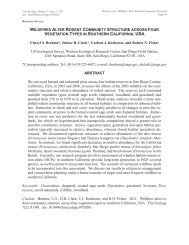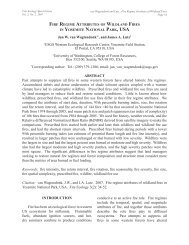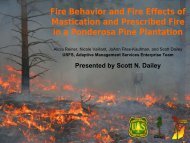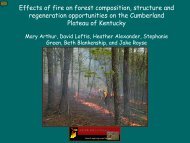Current Titles in Wildland Fire, May 2012 - Association for Fire Ecology
Current Titles in Wildland Fire, May 2012 - Association for Fire Ecology
Current Titles in Wildland Fire, May 2012 - Association for Fire Ecology
Create successful ePaper yourself
Turn your PDF publications into a flip-book with our unique Google optimized e-Paper software.
<strong>Current</strong> <strong>Titles</strong> <strong>in</strong> <strong>Wildland</strong> <strong>Fire</strong>, <strong>May</strong> <strong>2012</strong><br />
Title: is Foliar Flammability of Woody Species Related to Time S<strong>in</strong>ce <strong>Fire</strong> and Herbivory <strong>in</strong><br />
Northwest Patagonia, Argent<strong>in</strong>a<br />
Source: Journal of Vegetation Science, Available Onl<strong>in</strong>e, February, <strong>2012</strong> Year: <strong>2012</strong> Keywords:<br />
<strong>Ecology</strong> Wildlife Argent<strong>in</strong>a Abstract: at Plant Level, Variability <strong>in</strong> Flammability-related Foliar<br />
Properties is Strongly and Consistently Related to Time S<strong>in</strong>ce Last <strong>Fire</strong>, Whereas Effects of<br />
Cattle Are More Variable Across Species and treatments. In Comparison With Unburned<br />
Forests, the Dom<strong>in</strong>ant Woody Species at Shrubland Sites Showed Reduced Leaf Moisture, Leaf<br />
Size and Specific Leaf Area. Under Pressure From Cattle, n. Antarctica, One of the Most<br />
Important Woody Species <strong>in</strong> These Shrublands, Showed Changes <strong>in</strong> Some Foliar Traits<br />
Expected to Enhance Flammability (e.g. Shorter Time to Ignition) but Overall the Influence of<br />
Cattle on Flammability Was Not Consistent. The <strong>Current</strong> Study Demonstrates that Plant Foliar<br />
Traits Vary Between Recently Burned and Unburned Sites, and that These Variations may<br />
Enhance Foliar Flammability <strong>in</strong> Shrubland Communities. How to Locate: Contact<br />
Meliblackhall@gmail.com<br />
Author(s): Blake, David, Katie Lu, Pierre Horwitz and Mary C. Boyce<br />
Title: <strong>Fire</strong> Suppression and Burnt Sediments: Effects on the Water Chemistry of <strong>Fire</strong>-affected<br />
Wetlands<br />
Source: International Journal of <strong>Wildland</strong> <strong>Fire</strong>, Available Onl<strong>in</strong>e, April <strong>2012</strong> Year: <strong>2012</strong><br />
Keywords: Erosion Soils Wetlands <strong>Ecology</strong> Acid Sulfate Soils, Kilfire, Phos-chek Abstract:<br />
Prevent<strong>in</strong>g <strong>Fire</strong> From Enter<strong>in</strong>g Wetland Areas Dur<strong>in</strong>g Seasonal or Prolonged Drought, or<br />
Suppress<strong>in</strong>g <strong>Fire</strong> Once It Has Entered A Wetland, Requires Consideration of the Consequences<br />
of the fire-management Action on Water Quality. Two Approaches Can Be Taken to Suppress<br />
Such <strong>Fire</strong>s: Chemical <strong>Fire</strong> Retardants or the Flood<strong>in</strong>g of Sediments. We Determ<strong>in</strong>e A Lack of<br />
In<strong>for</strong>mation Relat<strong>in</strong>g to the Effects of These Approaches <strong>for</strong> Water Quality With<strong>in</strong> <strong>Fire</strong>affected<br />
Wetlands. The Aim of This Study Was to Ga<strong>in</strong> A Prelim<strong>in</strong>ary Understand<strong>in</strong>g of the<br />
Effects of Three Treatments: Two Chemical treatments and Saturation. Microcosms Were<br />
Established to Test Sediments From A Wetland on the Swan Coastal Pla<strong>in</strong>, Western Australia,<br />
Which Were Exposed to Temperatures Rang<strong>in</strong>g From 30 to 800xc. The Results Indicate that<br />
One of the <strong>Fire</strong>-retardant Chemicals Increased the Soluble Nutrient Load Present <strong>in</strong> the Water<br />
Column, as Predicted by the Results of Other Research. However, the Same chemical Had A<br />
M<strong>in</strong>or but Important Effect as An Acidity Buffer When the Organic, Pyritic Sediment Was<br />
Heated but Not Burnt. The Second Chemical Treatment Did Not Increase the Nutrient Load but<br />
neither Did It Buffer the Acidity Generated by the Heat<strong>in</strong>g and Burn<strong>in</strong>g of the Organic<br />
Sediment. It Was Virtually Indist<strong>in</strong>guishable From the Saturation Treatment <strong>in</strong> This Regard.<br />
How to Locate: Contact D.blake@ecu.edu.au<br />
Author(s): Bodi, M. B. Doerr, S. H., Cerda, A. and Mataix-solera, J.<br />
Title: Hydrological Effects of A Layer of Vegetation Ash on Underly<strong>in</strong>g Wettable and Water<br />
Repellent Soil<br />
Source: Geoderma, <strong>in</strong> Press Year: <strong>2012</strong> Keywords: Hydrology Soils Wettability Abstract:<br />
Hydrological Processes After A Wildfire <strong>May</strong> Take Place Under Soil Conditions Altered by Heat<br />
and by the Presence of Ash. Soil and Ash Interact as A Two-layer System With Poorly<br />
Understood hydrological Properties, Especially When Ash Covers Water Repellent Soil. Here<br />
10








